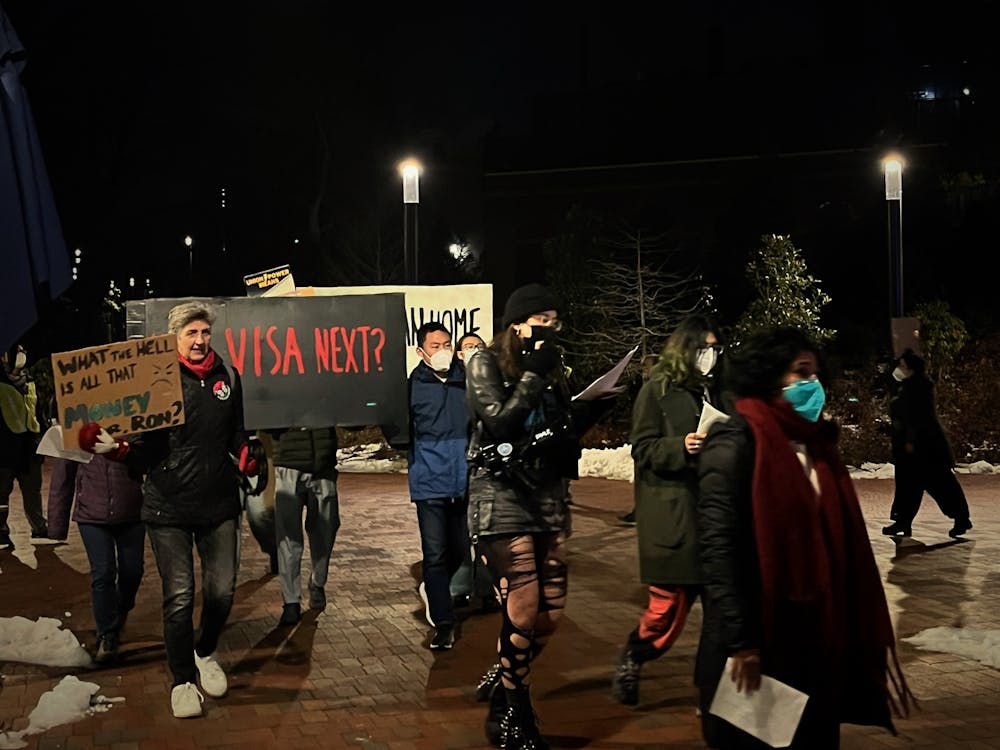At their weekly meeting on Tuesday, the Student Government Association (SGA) discussed the University’s revised protest guidelines.
The revised guidelines, which were released on Jan. 29, incorporated student feedback after an earlier version was deemed too restrictive. However, the guidelines are still perceived as obstructive to student activism on campus.
SGA members also talked about improving gender equity for faculty and staff, including mothers having means to gain tenure and access to affordable childcare. Members also discussed funding a banner for Marjory Stoneman Douglas High School (Stoneman Douglas) at Parkland, Fla. to show support for its students in light of the fatal shooting there on Feb. 14.
Moses Davis, associate dean of diversity and inclusion, attended the SGA meeting to receive feedback on the guidelines.
Senior Class Senator Joshua Bertalotto believes the guidelines give the University too much authority.
“My main problem with the guidelines that are listed is that it leaves so much leeway for the administration and the University to say what is and what isn’t a right protest,” Bertalotto said.
He said that the guidelines may pose a threat to students’ right to demonstrate.
“The idea of there being guidelines on something that we’re saying is free expression is really problematic,” Bertalotto said.
The guidelines say that students “should” reserve spaces where they wish to have the protest ahead of time. Students complained that the only people who have the ability to reserve spaces on campus are members of student organizations.
In order for students to reserve spaces on campus, they must submit a request 10 business days in advance for their request to be processed.
Senior Class President Kwame Alston believes the guidelines go against the spirit of a student protest.
“The point of a protest is disruption,” Alston said.
Davis explained that the administration’s rationale is that these guidelines would permit different student groups to host their own protests. He said that the guidelines help create a more organized system to protect students’ freedom of expression.
Other students believed that these guidelines reinforce their belief that the University does not take student protests and interests seriously. Alston discussed the administration’s response to student activism following the Baltimore Uprising which occurred after Freddie Gray, a 25-year-old black Baltimore resident died in police custody.
“In my freshman year, [the University] accidentally sent out an accidental email comparing the things that were going on with Freddie Gray to a snow day,” Alston said. “This administration just doesn’t have a history of actually caring about protests.”
Students suggested to Davis that the University should make sure that the guidelines are suggestions rather than rules.
“We talked to a student group last week and they did say that [the guidelines] look punitive and not supportive,” Davis said.
Students suggested to Davis that instead of the guidelines, the administration should put together an outreach program, where student activists are able to reach out to administrators who could provide them with information as to how to hold an effective protest.
Other topics discussed included promoting gender equality among faculty. Anne-Elizabeth Brodsky, co-chair of the Krieger School of Arts and Sciences Committee on the Status of Women, came to discuss several problems that the group is currently focused on, including expanding the organization.
The Committee is selective and was founded in 2002 to write the Vision 2020 report, published in 2006 on the status of women at Hopkins. The Committee calls for more action by the University to promote better resources and opportunities on campus.
One ongoing issue is the availability of childcare for staff members. Brodsky said that while childcare is available, it is not affordable for many faculty and staff.
“We have excellent top-shelf childcare, but it’s not at a price point that’s accessible to a lot of faculty and staff,” Brodsky said.
Brodsky stated that starting faculty usually start at around $42,000 per year and that infant care at the Homewood Early Learning Center is $22,000 per year. She stated that graduate students earn typically $30,000 per year and that the childcare provided is extremely unaffordable.
Brodsky explained that for women in academia, there are many instances where they will be treated differently from their male counterparts.
“If you have a child and you are a woman on the tenure track, you are significantly less likely to get tenure,” she said. “If you are a man and you have a child and are up for tenure, you are more likely to get tenure.”
Brodsky said that when people worry if they will get tenure it negatively impacts their work in the classroom. She believes that because this directly affects students, Hopkins should be conscious of how to make these opportunities equal for all genders.
In addition, the SGA also agreed to commission a banner to be sent to Stoneman Douglas. This motion was brought to the floor by a Hopkins sophomore who graduated from Stoneman Douglas.
The student’s brother currently attends the school and recently lost his best friend in the shooting, which resulted in the deaths of 17 people. SGA members agreed that the banner would be a good way to support Stoneman Douglas and other members of the Hopkins community affected by the shooting.




